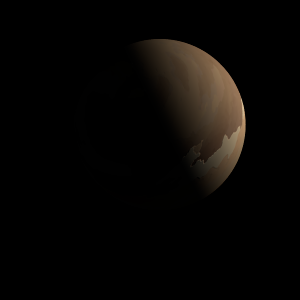|
|
Space Astro
|
Info for exoplanet "Aecaher"
| Scientific (actual) data |
|---|
| Planet | K2-129 b |
| Planet status | Confirmed |
| Radius | 0.093 |
| Orbital period | 8.23949 |
| Semi major axis | 0.057 |
| Orbit eccentricity | 0.13 |
| Inclination | 89.21 |
| Discovered | 2017 |
| Updated | 2021-02-05 |
| Omega | 39.89 |
| Tconj | 2457340 |
| Tzero tr | 2457340 |
| Publication | Published in a refereed paper |
| Detection type | Primary Transit |
| Radius detection type | Primary Transit |
| Alternate names | EPIC 214787232 b, 2MASS J19163558-2538417 b, EPIC 214787262 b, EPIC 214787262.01, WISE J191635.63-253845.2 b |
| Star name | K2-129 |
| Right ascension | 289.15° |
| Declination | -25.65° |
| Mag j | 9.697 |
| Mag h | 9.102 |
| Star distance | 27.82 |
| Star mass | 0.36 |
| Star radius | 0.36 |
| Star sp type | M3V |
| Star temperature | 3459.09 |
| Star alternate names | EPIC 214787262, LP 868-19, 2MASS J19163558-2538417, WISE J191635.63-253845.2 |
| Wikipedia article | K2-129 b |
Back
| |
| Fictional info (?) |
|---|
| Suggested name | Aecaher |
| Planet type | Warm planet |
| When viewed from Time Pe, Aecaher can reach an apparent magnitude of -3, bright enough for its reflected light to cast shadows, and making it on average the third-brightest object in the night sky. The planet is named after the deity Aecaher, the goddess of fear.
Having almost no atmosphere to retain heat, it has surface temperatures that vary diurnally more than on any other planet in its solar system, ranging from 125°K (-148°C) at night to 420°K (147°C) during the day across the equatorial regions.
Because of its fast rotation, the planet's shape is that of an oblate spheroid (it has a slight but noticeable bulge around the equator). The largest moon, Catur Daph, has a diameter greater than that of the planet Mars.
The Aecaher system has a unique configuration among those of the planets because its axis of rotation is tilted sideways, nearly into the plane of its solar orbit.
One of this planet's moons is entirely inhabitated by harmless medieval bacteria that spend their life while devouring the somewhat smaller "Siri" during the day. Most Camelene-deuces are related to the Theemaka but have 7 eyes and vary in length from 7 to 17 cm. They can endure temperatures from 150 to 200°C and to some degree ultra violet light which is common on Aecaher. |
| Estimated population | 2400000 |
| Atmosphere | Methane | 66% |
| Carbon dioxide | 28% |
| Oxygen | 5.4% |
| Water | 0.0005% |
| Atmospheric pressure | 9 bar |
 |
| Moon | Catur Daph | Large irregular gaseous planetoid |
| Google search for Aecaher |
|
Website by Joachim Michaelis
|
|
|
|